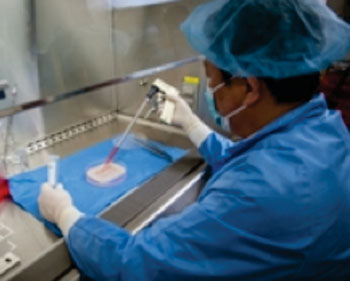Project to Move Engineered Tissue and Organs from Lab to the Bedside, Operating Room
By LabMedica International staff writers
Posted on 13 May 2014
As developments in lab-created organs and tissues continue to advance, the challenge becomes how to translate the technology from the laboratory to the operating room. Two US universities are now exploring manufacturing platforms to mass produce customized engineered tissues and organs. Posted on 13 May 2014
Developing a way to scale up personalized lab-created organs and tissues would benefit patients around the world who must wait for donated organs to receive transplants. North Carolina (NC) State University’s (Raleigh, NC, USA) industrial and systems engineering department (NC State ISE) engineers are partnering with biomedical scientists at the Wake Forest Institute for Regenerative Medicine (WFIRM; Winston-Salem, NC, USA). Together, the institutions are creating advancements in 3D technology, computer-aided modeling and intelligent automation to print tissues and organs for patients. With their focus on precision, computer modeling and three-dimensional (3D) printing will help scientists scale up the tissue engineering processes currently being done manually.

Image: Lab-grown vaginal organs implanted in patients (Photo courtesy of the Wake Forest Institute for Regenerative Medicine).
The future of organs-on-demand requires the mass generation of precise parts that are specific to each individual recipient. The development entails combining the cells and a scaffold, or a model that forms the essential shape. The support structure is designed to gradually dissolve after implantation in the body. At the same time, the scaffolding material is being absorbed by the body, and the cells lay down materials to form a permanent support structure, progressively replacing the engineered scaffold with a new organ.
Leading corporate and education specialists in medicine, engineering, and science gathered at this year’s Regenerative Medicine Foundation Conference, May 5-7, 2014, held in San Francisco, CA, USA, to share firsthand accounts of their visions and challenges of bio-tissue manufacturing. Dr. Binil Starly, director of NC State ISE’s laboratory for engineering biological tissue systems, uses bioprinting to devise ways for mass producing engineered tissue and also shared data about these latest developments, including a patent-pending process, which is collaboration between WFIRM and NCSU, for providing replacement skin for burn victims.
“It is one thing to be able to grow an organ but another to take that ability to the bedside, so involving manufacturing engineers early on in the biological research phase is vital to achieving commercialization,” said Dr. Starly. “NC State ISE reviews the scientific process for growing tissue cells, and then applies 3D technologies and algorithms to automate it, so a very sensitive biological process can be replicated safely and effectively.”
Dr. Anthony Atala, director of WFIRM and NC State ISE advisory board member, moderated a panel on the marketing of regenerative medicine therapies at the conference. WFIRM scientists have developed lab-grown organs, such as bladders, vaginal organs, and urine tubes successfully used in patients.
Related Links:
North Carolina State University
Wake Forest Institute for Regenerative Medicine













